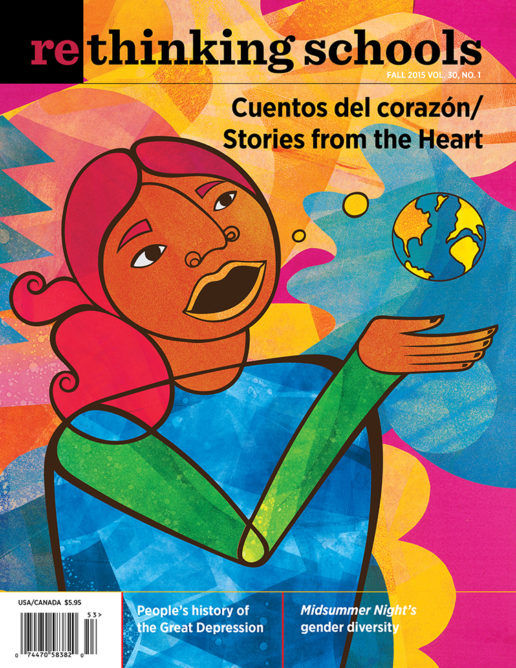Bilingual Education: Stories from the Heart
Illustrator: Favianna Rodriguez

As always, Rethinking Schools has several new books in process. This issue we feature three articles destined for one of these: Rethinking Bilingual Education, edited by Grace Cornell Gonzales, Elizabeth Barbian, and Pilar Mejia.
Nothing reveals our attitudes about our students more clearly than the stance we take toward their home languages. Do we advocate for students’ right to education in their home language? Do we welcome their multilingual “stories from the heart,” and use them to anchor our curriculum, or do we demand English-only conformity? In “English-Only to the Core,” Jeff Bale shows how struggles over bilingual education have always been about the kind of society we want to live in: “It was the actions of Chicana/o, Puerto Rican, Native American, and Asian American activists in the 1960s and ’70s that brought about bilingual education in the first place. As these activists focused on schools, they combated segregation and a lack of resources, and demanded bilingual and bicultural programming.”
Schools were—and are—one front in an anti-racist battle for democracy. And, Bale argues, it is within this broader social context that we should view the attacks on bilingual education. Efforts to roll back bilingual education “were part of a larger wave of anti-immigrant racism that had grown significantly in the 1990s. . . . Bilingual education has long been low-hanging political fruit for anti-immigrant racists.” In his article, Bale takes this one step further, arguing that, in their implementation, the Common Core State Standards—although superficially more alert to multicultural themes—are fundamentally hostile to linguistic diversity.
In their poignant “Cuentos del corazón (Stories from the Heart): An After-School Writing Project for Bilingual Students and their Families,” Jessica Singer Early and Tracey Flores describe how they built a bilingual, bi-generational writing community in the face of Arizona’s English-only curriculum and anti-immigrant raids. Rethinking Schools has long advocated grounding the curriculum in our students’ lives, and Early and Flores offer moving testimony about what this can look like when families’ lives, languages, and stories are celebrated.
Sandra L. Osorio begins “Qué es deportar?: Teaching from Students’ Lives” with her own experiences as a bilingual elementary student: “At school, I don’t remember ever reading a story with a main character who was bilingual or bicultural.” She commits herself to a different kind of teaching, one that builds from Latino/a students’ real experiences, including painful stories of deportation. This means challenging the school’s ostensibly bilingual curriculum—based on a Spanish translation of the English basal. In this reader, the stories’ words were in Spanish, but the themes were a world away from her students’ lived experiences.
These articles are evidence that the movement for bilingual and bicultural education has not been destroyed by the right-wing English-only proponents. Injured, yes; destroyed, no.
Education in one’s native language is a human right. Rethinking Bilingual Education, including the articles we feature in this issue of Rethinking Schools, will be a contribution in solidarity with those struggling for an education that supports the multilingual, multicultural, democratic society we hope to live in.
As efforts to discredit, undermine, and privatize public schools become shriller and more audacious, sometimes we feel pushed into a purely defensive stance. Yes, we need to do everything we can to defend public education. But we also need to rethink and revitalize it. Other articles in this issue of the magazine show some of the ways educators are reimagining our classrooms and schools.
In “Baby Mamas in Literature and Life,” English teacher Abby Kindelsperger describes a unit she developed based on teen pregnancy and motherhood. Inspired by her alternative high school students’ responses to her own pregnancy, Kindelsperger’s curriculum rejects the common deficit-based narrative of teen parenting. Instead, her class explores literature, popular culture, and even billboards as they “re-frame the issue as part of an investigation of the complexity of life and the web of power, gender, race, and class.”
“Who Made the New Deal” begins Rethinking Schools editor Adam Sanchez’s two-part series on teaching a people’s history of the Great Depression. So often, the New Deal is presented as if significant change originated at the top: Franklin Roosevelt, the “people’s president,” proposing an alphabet soup of programs to help ordinary workers and the poor. Through simulation and role play, Sanchez engages his students in taking a closer look. Part one, in this issue, describes how he teaches the origins of the Depression through the playful Widget Boom Game.
Lauren Porosoff’s “A Midsummer Night’s Gender Diversity” is previewed from Rethinking Sexism, Gender, and Sexuality, which we are publishing this fall. Porosoff was teaching A Midsummer Night’s Dream when one of her middle schoolers asked her, “Ms. Porosoff, are we going to do anything with this book? You know, besides read it out loud and have you translate it for us?” This uncomfortable challenge led Porosoff to center their study of the comedy on how Shakespeare plays with gender expression and expectations.
High school assemblies offer a window into which students’ lives matter at school, and whose leadership and participation is valued. In “The Hidden Agenda of High School Assemblies,” Oregon teacher Jessica Richter-Furman shares her journey of discovery about why assemblies are so white in a school that is much more diverse, and offers her thoughts on how to initiate change.
Finally, we want to highlight a few of the conferences in the fall where educators will come together to explore ways to resist public school privatization and build schools that reflect values of equality and justice. For years, we’ve been going to the excellent Teachers 4 Social Justice conference, held every year at Mission High School in San FranciscoÑthis year on Saturday, Oct. 10. The T4SJ conference inspired teachers in the Northwest, who will hold their 8th annual Northwest Teaching for Social Justice gathering the following weekend, Saturday, Oct. 17—this year at Chief Sealth International High School in Seattle. The annual Teachers for Social Justice Curriculum Fair will be in Chicago on Saturday, Nov. 21. Rethinking Schools editors will be presenting workshops and staffing tables with books, magazines, and conversation at all of these. We hope to see you at one of them.
And one more thing. Many Rethinking Schools editors have been reading Ta-Nehisi Coates’ memoir, Between the World and Me, written as a letter to his 15-year-old son. It’s a searing chronicle about the violence of racism. Toni Morrison calls it “required reading.” We agree.

